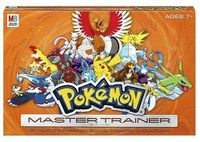Pokémon Master Trainer (2005)
Pokémon Master Trainer is a board game for two to four players produced in 2005 by Hasbro and Milton Bradley. The object of the game is to travel from the starting place to the finish with the most Pokémon Chips (PCs), which are used as money. Along the way, players PCs, catch Pokémon, and participate in battles. There are 204 Pokémon from Generations I, II, and III available.
This is the third game bearing the Pokémon Master Trainer moniker, despite being a radically different game than its predecessors.
Gameplay
Each player controls one of four pawns: Ash, May, Max, or Brock. Players start out with 100 PCs (which come in 10s, 20s, and 50s), three random Pokémon, and three random Items. The players spin for movement.
Battling
Battling, like moving, makes use of the spinner. In a wild Pokémon battle, a player spins the spinner (which has the numbers 0, 1, 2, 3, 4, 5, 6, and 10) and adds the resulting number to their Pokémon's Battle Points. The player may choose to play Item or Event cards that will add to that total. Then another player spins for the wild Pokémon and adds that number to the Pokémon's BPs. If the player trying to capture the wild Pokémon has a higher total, they add that Pokémon to their team (there is no limit to the amount of Pokémon you can have).
Battling between players is slightly different; whoever wins receives both Pokémon that participated.
When a player encounters a Rare (legendary) Pokémon, no battle ensues; the player must spin a six or a ten, and if successful, receives the Rare Pokémon.
In all battles, a player is allowed to use only one Pokémon; no Double Battles, switching, or replacements are allowed.
Cards
There are several different cards in this game: Pokémon Character cards, which include all non-legendary Pokémon, Rare Pokémon cards (legendary Pokémon), Item cards, Event cards, Gym Leader cards, and Smile Loan cards.
The Pokémon Character cards make up 192 of the 204 featured Pokémon and are divided into three colors: yellow, orange, and red. Yellow Pokémon are the weakest, with either four or five Battle Points (BPs). All the basic forms of the starter Pokémon (as of Generation III) are included in this category, besides some other low-level Pokémon like Jigglypuff. Orange Pokémon are medium strength, with BPs of either six or seven. They include all the middle stages of the Starter Pokémon as well as evolved Pokémon like Slowbro and strong unevolved Pokémon like Aipom and Diglett. Red Pokémon are strong, with BPs of either eight or nine. They include all the final stages of the Starter Pokémon in addition to other powerful fully-evolved Pokémon like Flygon and rare non-legendary Pokémon like Lapras.
Rare Pokémon cards include all the legendary Pokémon in Generations I-III, with two Deoxys (Attack Forme and Defense Forme). The legendary birds, beasts, and titans and the Eon duo have ten BPs. The Weather trio, Tower duo, Mewtwo, and Deoxys (Defense Forme) have eleven BPs. Mew, Celebi, Jirachi, and Deoxys (Attack Forme) have 12 BPs.
Item cards can be used to add to the total BPs in battles, to avoid battles, or to add to movement on the board. Once they are used, they return to the Item deck. A player may only carry six Item cards at a time.
Event cards are rather like the Chance and Community Chest cards in Monopoly. Sometimes a player wins PCs. Sometimes they lose PCs or Pokémon as a result of meeting with Team Aqua, Team Magma, or Team Rocket.
Gym Leader cards initiate Pokémon Gym battles. These battles are special; no Item or Event cards may be used. There are eight Gym Leader cards, one for each Hoenn Gym Leader. Gym Leaders have their own BPs, which range from twelve to sixteen depending on the leader in question. If a player beats a Gym Leader, they receive two free Pokémon. If they lose, they must pay a fee of 20 PCs.
Smile Loan cards are all the same. If a player runs out of PCs, they may take a Smile Loan card, which entitles them to 100 PCs from the bank. The player must pay the bank 120 PCs by the time they reach the finish for every Smile Loan card they took.
Spaces
There are several different types of spaces players may land on. Sometimes they will win free PCs, sometimes they have to spin for PCs. Occasionally a player will land on a bad space and lose PCs or Pokémon. Many of the spaces trigger wild Pokémon battles and inter-player battles, and a few trigger encounters with Rare Pokémon. If a player gets lucky they will land on a space with Professors Oak or Birch, who have two free Pokémon to offer. All the card types except the Smile Loan cards have their own spaces; for example, Item and Event spaces.
Trivia
- Pidgeotto's BP level is 4, the lowest possible, a trait it shares with such weak Pokémon as Cleffa and Togepi. It is unknown why an evolved Pokémon was grouped with weaker ones, or why neither of its evolutionary relatives (Pidgey and Pidgeot) were included in the game at all.
- Igglybuff, a baby Pokémon, has six BPs, while its evolved form, Jigglypuff, has only five.
- Probably because Ash's Pikachu is so strong in the anime, Pikachu is given a BP level of 8, unusually high.
Related articles

|
This article is part of Project Merchandise, a Bulbapedia project that aims to write comprehensive articles on all Pokémon toys, dolls, books, and collectible merchandise. |
